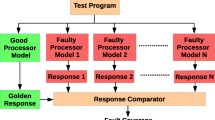Abstract
Software-based self-testing (SBST) is introduced for at-speed testing of processors, which is difficult with any of the external testing techniques. Evolutionary approaches are used for the automatic synthesis of SBST programs. However, a number of hard-to-detect faults remain unidentified by these autogenerated test programs. Also, these approaches have considered fault models which have low correlation with the gate-level fault models. This paper presents a greed-based strategy, where the instruction sequences that detect the freshly identified faults are preserved throughout the evolutionary process to identify the hard-to-test faults of the processor. Subsequently, the overall coverage is also improved. A selection probability is estimated from the testability properties of the processor components and assigned to every instruction to accelerate the test synthesis. The range of performance and scalability are comprehensively evaluated on a configurable MIPS processor and a full-fledged 7-stage pipeline SPARC V8 Leon3 soft processor using behavioral fault models. The efficacy of our approach was explained by demonstrating the correlation between behavioral faults and gate-level faults of MIPS processor for the proposed scheme. Experimental results show that improved coverages of 96.32% for the MIPS processor and 95.8% for the Leon3 processor are achieved in comparison with the conventional methods, which have about 90% coverage on the average.
























Similar content being viewed by others
References
Bernardi P, Sanchez EES, Schillaci M, Squillero G, Reorda MS (2008) An effective technique for the automatic generation of diagnosis-oriented programs for processor cores. IEEE Trans Comput Aided Des Integr Circuits Syst 27(3):570–574
Chen C-IH (2003) Behavioral test generation/fault simulation. IEEE Potentials 22(1):27–32
Corno F, Cumani G, Reorda MS, Squillero G (2000) An RT-level fault model with high gate level correlation. In: Proceedings of the IEEE international high-level design validation and test workshop, pp 3–8
Corno F, Sánchez E, Reorda MS, Squillero G (2004) Automatic test program generation: a case study. IEEE Des Test Comput 21(2):102–109
Corno F, Sánchez E, Squillero G (2005) Evolving assembly programs: how games help microprocessor validation. IEEE Trans Evol Comput 9(6):695–706
Danek M, Kafka L, Kohout L, Skora J (2014) R Bartosinski Utleon3: exploring fine-grain multi-threading in fpgas. ISBN: 978-1-4614-2410-9
Gizopoulos D, Paschalis A, Zorian Y (2013) Embedded processor-based self-test, vol 28. Springer Science & Business Media, Berlin. ISBN: 978-1-4020-2801-4
Gizopoulos D, Psarakis M, Hatzimihail M, Maniatakos M, Paschalis A, Raghunathan A, Ravi S (2008) Systematic software-based self-test for pipelined processors. IEEE Trans Very Large Scale Integr Syst 16(11):1441–1453
Hudec J, Gramatová E (2015) An efficient functional test generation method for processors using genetic algorithms. J Electr Eng 66(4):185–193
Karputkin A, Raik J (2016) A synthesis-agnostic behavioral fault model for high gate-level fault coverage. In: Proceedings of the design, automation & test in Europe conference & exhibition (DATE), pp 1124–1127
Karunaratne M, Sagahayroon A, Prodhuturi S (2005) RTL fault modeling. In: Proceedings of the 48th midwest symposium on circuits and systems, pp 1717–1720
Kranitis N, Paschalis A, Gizopoulos D, Xenoulis G (2005) Software-based self-testing of embedded processors. IEEE Trans Comput 54(4):461–475
Kranitis N, Paschalis A, Gizopoulos D, Zorian Y (2003) Instruction-based self-testing of processor cores. J Electron Test 19(2):103–112
Leveugle R, Hadjiat K (2003) Multi-level fault injections in vhdl descriptions: Alternative approaches and experiments. J Electron Test 19(5):559–575
Sánchez E, Reorda MS, Squillero G (2006) Efficient techniques for automatic verification-oriented test set optimization. Int J Parallel Prog 34(1):93–109
Squillero G (2005) Microgp—an evolutionary assembly program generator. Genet Program Evolvable Mach 6(3):247–263
Author information
Authors and Affiliations
Corresponding author
Additional information
Responsible Editor: D. Gizopoulos
Rights and permissions
About this article
Cite this article
Suryasarman, V.M., Biswas, S. & Sahu, A. Automation of Test Program Synthesis for Processor Post-silicon Validation. J Electron Test 34, 83–103 (2018). https://doi.org/10.1007/s10836-018-5709-x
Received:
Accepted:
Published:
Issue Date:
DOI: https://doi.org/10.1007/s10836-018-5709-x




